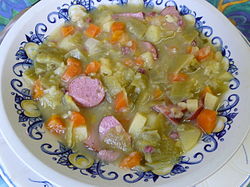You can help expand this article with text translated from the corresponding article in Luxembourgish. (May 2016)Click [show] for important translation instructions.
|
This article includes a list of general references, but it lacks sufficient corresponding inline citations .(February 2013) |
 | |
| Type | Soup |
|---|---|
| Place of origin | Luxembourg |
| Main ingredients | Green beans, potatoes, bacon, onions |
Bouneschlupp is a traditional Luxembourgish green bean soup with potatoes, bacon, and onions. [1] [2]
Contents
Although Bouneschlupp is considered a Luxembourgish national dish, it can also be found in Saarland (Germany), Gaume, Arelerland (Belgium), and Lorraine (France).